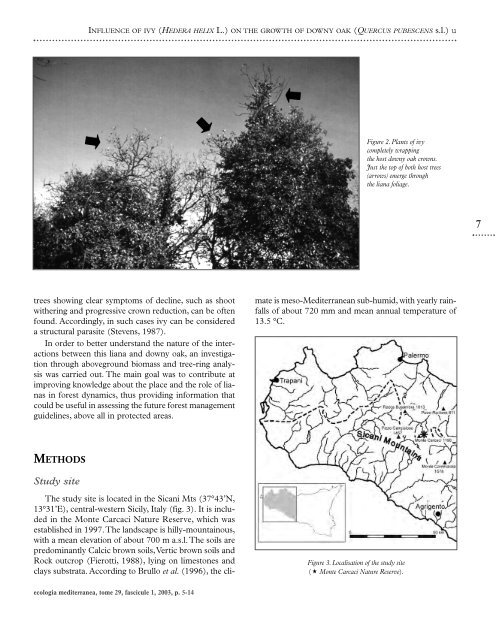introduction - Ecologia Mediterranea
introduction - Ecologia Mediterranea
introduction - Ecologia Mediterranea
You also want an ePaper? Increase the reach of your titles
YUMPU automatically turns print PDFs into web optimized ePapers that Google loves.
INFLUENCE OF IVY (HEDERA HELIX L.) ON THE GROWTH OF DOWNY OAK (QUERCUS PUBESCENS s.l.) u<br />
trees showing clear symptoms of decline, such as shoot<br />
withering and progressive crown reduction, can be often<br />
found. Accordingly, in such cases ivy can be considered<br />
a structural parasite (Stevens, 1987).<br />
In order to better understand the nature of the interactions<br />
between this liana and downy oak, an investigation<br />
through aboveground biomass and tree-ring analysis<br />
was carried out. The main goal was to contribute at<br />
improving knowledge about the place and the role of lianas<br />
in forest dynamics, thus providing information that<br />
could be useful in assessing the future forest management<br />
guidelines, above all in protected areas.<br />
METHODS<br />
Study site<br />
The study site is located in the Sicani Mts (37°43’N,<br />
13°31’E), central-western Sicily, Italy (fig. 3). It is included<br />
in the Monte Carcaci Nature Reserve, which was<br />
established in 1997.The landscape is hilly-mountainous,<br />
with a mean elevation of about 700 m a.s.l. The soils are<br />
predominantly Calcic brown soils,Vertic brown soils and<br />
Rock outcrop (Fierotti, 1988), lying on limestones and<br />
clays substrata. According to Brullo et al. (1996), the cli-<br />
ecologia mediterranea, tome 29, fascicule 1, 2003, p. 5-14<br />
Figure 2. Plants of ivy<br />
completely wrapping<br />
the host downy oak crowns.<br />
Just the top of both host trees<br />
(arrows) emerge through<br />
the liana foliage.<br />
mate is meso-<strong>Mediterranea</strong>n sub-humid, with yearly rainfalls<br />
of about 720 mm and mean annual temperature of<br />
13.5 °C.<br />
Figure 3. Localisation of the study site<br />
( Monte Carcaci Nature Reserve).<br />
7
















